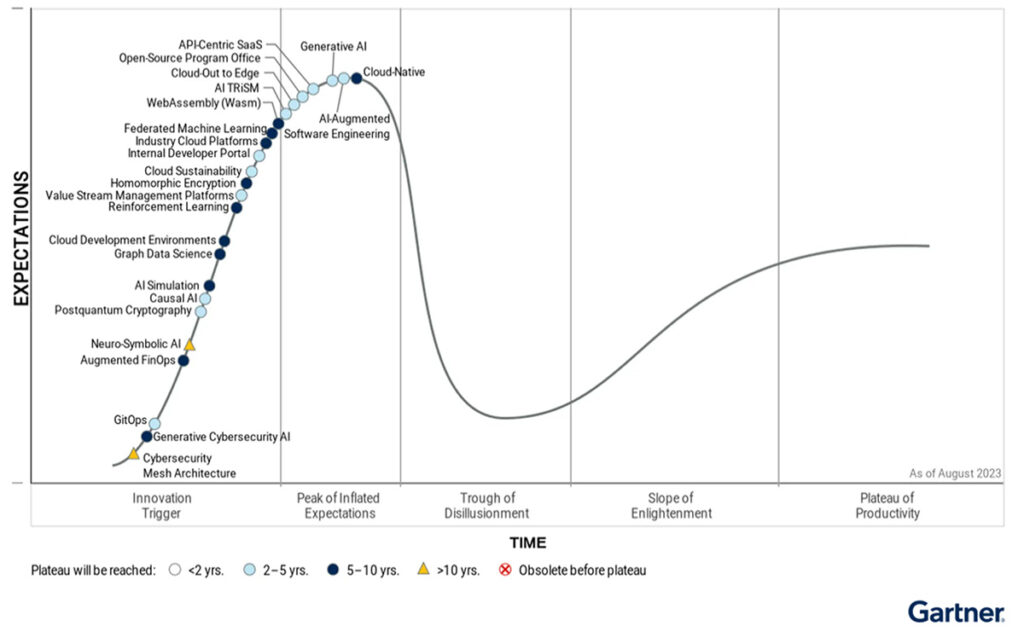How generative AI will usher in a new era of productivity
Since 2005, non-farm US labor productivity—defined as the economic output per hour worked—has grown at a lacklustre 1.4% per annum. In 2022, it fell 1.7%, the largest decline seen in four decades.[1] If booming adoption of artificial intelligence (AI) could help reverse that trend, returning productivity growth to the long-term average of 2.2% since World War II, US GDP would receive an estimated $10 trillion boost—equivalent to $15,000 per household.[2]
Most other developed nations face a similar productivity challenge. AI could help tackle it by freeing employees to focus on the core and creative aspects of their jobs, paving the way for a new wave of innovation and a happier, more efficient workforce. It could also help countries better respond to other looming challenges, including labour shortages, debt, inflation and the energy transition.
Among the various forms of AI, generative AI has been a surge in usage and awareness following the launch of ChatGPT in November 2022. According to leading technology research and consulting firm Gartner, generative AI has become the most mature among various major types of AI, with many of its valuable and transformative breakthroughs having already been made, and further benefits likely to plateau over a two-to-five-year horizon.[3]

Image source: https://www.zdnet.com/article/generative-ai-tops-gartners-top-25-emerging-technologies-list-for-2023/
As more firms and workers begin to adopt generative AI, Goldman Sachs estimates global productivity could increase by around 7% annually over the following decade.[4] The investment bank also predicts this will be accompanied by the loss of up to 300 million full-time jobs,[5] though it would create hundreds of new categories of jobs at the same time.
Meanwhile, AI’s proponents argue that rather than leading to widespread job cuts, the technology will help corporations scale sustainably by enabling greater agility, the cultivation of new revenue streams, and increased customer satisfaction. Although workers will need support in learning new skills, and some will change occupations, if worker transitions and other risks are adequately managed, generative AI could contribute substantively to economic growth and support a more sustainable and inclusive world.[6]
Of course, in the current environment of tight liquidity and high interest rates, firms may find it difficult to access capital to implement AI or upskill their employees. Fortunately, there is a compelling, progressive solution in the form of securities-based financing provided by EquitiesFirst.
Real-world impact
The efficiency gains from making such investments are significant and measurable.
In what is considered the first large-scale, real-world investigation of its kind, a study published recently by researchers at Stanford University and the Massachusetts Institute of Technology measured the impact of generative AI tools on the productivity of customer service workers at a Fortune 500 software firm over the course of a year.[7]
The productivity gains recorded were less pronounced than in previous experiments, likely because real-world workplace processes are more complicated than discreet lab-based tasks. But they were still dramatic: workers who were given access to generative AI tools became 14% more productive on average than those who were not.
And notably, the least-skilled workers saw the biggest gains, of 35%. The most highly skilled workers, on the other hand, saw little to no benefit from using AI.
Moreover, two separate studies in controlled environments found that business professionals who used AI could write 59% more business documents per hour[8] and programmers who used AI could code up to 126% more projects per week.[9] These studies, too, found that AI could help narrow the gap between the least and most skilled employees.
In all studies, the use of AI led to an increase in output per hour, but the study involving business document writing also saw a dramatic improvement in quality of work—presumably because professionals using AI were able to produce the first draft of document texts much more quickly, and therefore had more time to spend on editing and improving the final version.
A plethora of use cases
Of course, AI is being applied to a vastly wider array of use cases than generating content, from automated loan approvals to advanced medical diagnostics. It has been used to relieve traffic congestion, provide students with personalised lesson content, and pave the way to automate and streamline manufacturing, logistics and customer service.
AI’s impacts on corporate efficiency have been widespread and significant. Walmart, for example, has adopted AI strategically to optimise everything from stock and warehouse management to delivery schedules, claiming to have thereby increased employee productivity by up to 15%.[10]
The most common benefit of AI is improved efficiency and reduced cost, but firms wishing to implement it and upskill their employees to use it need to make significant upfront investments, which could be difficult to fund in the current climate of high interest rates and banks’ reluctance to lend. As companies struggle to invest sufficient resources to leverage AI and other new digital technologies, there could be a delay in achieving productivity gains,[11] hampering companies’ short-term profitability and potentially their long-term survival.
Securities-based financing can hasten the AI productivity revolution
Securities-based financing can help overcome this obstacle. It allows long-term investors and entrepreneurs to use their crypto or equities as collateral to raise capital to pursue AI-related investment themes or invest in upgrading their own firms’ AI capabilities.
Without having to sacrifice the upside potential of their current portfolio, investors can leverage securities-based financing to selectively gain exposure to AI’s ever-growing assortment of efficiency-enhancing opportunities.
[1] https://www.reuters.com/markets/us/us-fourth-quarter-labor-costs-revised-higher-productivity-growth-lowered-2023-03-02/
[2] https://www.mckinsey.com/mgi/our-research/rekindling-us-productivity-for-a-new-era#at-a-glance
[3] https://www.zdnet.com/article/generative-ai-tops-gartners-top-25-emerging-technologies-list-for-2023/
[4] https://edition.cnn.com/2023/03/29/tech/chatgpt-ai-automation-jobs-impact-intl-hnk/index.html#:~:text=300%20million%20jobs%20could%20be%20affected%20by,of%20AI%2C%20says%20Goldman%20Sachs&text=As%20many%20as%20300%20million,according%20to%20Goldman%20Sachs%20economists.
[5] https://edition.cnn.com/2023/03/29/tech/chatgpt-ai-automation-jobs-impact-intl-hnk/index.html#:~:text=300%20million%20jobs%20could%20be%20affected%20by,of%20AI%2C%20says%20Goldman%20Sachs&text=As%20many%20as%20300%20million,according%20to%20Goldman%20Sachs%20economists.
[6] https://www.mckinsey.com/capabilities/mckinsey-digital/our-insights/the-economic-potential-of-generative-ai-the-next-productivity-frontier
[7] https://www.bloomberg.com/news/articles/2023-04-24/generative-ai-boosts-worker-productivity-14-new-study-finds
[8] https://papers.ssrn.com/sol3/papers.cfm?abstract_id=4375283
[9] https://arxiv.org/abs/2302.06590
[10] https://www.cnbc.com/2023/03/27/how-walmart-is-using-ai-to-make-shopping-better.html
[11] https://www.ft.com/content/21384711-3506-4901-830c-7ecc3ae6b32a
Since 2005, non-farm US labor productivity—defined as the economic output per hour worked—has grown at a lacklustre 1.4% per annum. In 2022, it fell 1.7%, the largest decline seen in four decades.[1] If booming adoption of artificial intelligence (AI) could help reverse that trend, returning productivity growth to the long-term average of 2.2% since World War II, US GDP would receive an estimated $10 trillion boost—equivalent to $15,000 per household.[2]
Most other developed nations face a similar productivity challenge. AI could help tackle it by freeing employees to focus on the core and creative aspects of their jobs, paving the way for a new wave of innovation and a happier, more efficient workforce. It could also help countries better respond to other looming challenges, including labour shortages, debt, inflation and the energy transition.
Among the various forms of AI, generative AI has been a surge in usage and awareness following the launch of ChatGPT in November 2022. According to leading technology research and consulting firm Gartner, generative AI has become the most mature among various major types of AI, with many of its valuable and transformative breakthroughs having already been made, and further benefits likely to plateau over a two-to-five-year horizon.[3]

Image source: https://www.zdnet.com/article/generative-ai-tops-gartners-top-25-emerging-technologies-list-for-2023/
As more firms and workers begin to adopt generative AI, Goldman Sachs estimates global productivity could increase by around 7% annually over the following decade.[4] The investment bank also predicts this will be accompanied by the loss of up to 300 million full-time jobs,[5] though it would create hundreds of new categories of jobs at the same time.
Meanwhile, AI’s proponents argue that rather than leading to widespread job cuts, the technology will help corporations scale sustainably by enabling greater agility, the cultivation of new revenue streams, and increased customer satisfaction. Although workers will need support in learning new skills, and some will change occupations, if worker transitions and other risks are adequately managed, generative AI could contribute substantively to economic growth and support a more sustainable and inclusive world.[6]
Of course, in the current environment of tight liquidity and high interest rates, firms may find it difficult to access capital to implement AI or upskill their employees. Fortunately, there is a compelling, progressive solution in the form of securities-based financing provided by EquitiesFirst.
Real-world impact
The efficiency gains from making such investments are significant and measurable.
In what is considered the first large-scale, real-world investigation of its kind, a study published recently by researchers at Stanford University and the Massachusetts Institute of Technology measured the impact of generative AI tools on the productivity of customer service workers at a Fortune 500 software firm over the course of a year.[7]
The productivity gains recorded were less pronounced than in previous experiments, likely because real-world workplace processes are more complicated than discreet lab-based tasks. But they were still dramatic: workers who were given access to generative AI tools became 14% more productive on average than those who were not.
And notably, the least-skilled workers saw the biggest gains, of 35%. The most highly skilled workers, on the other hand, saw little to no benefit from using AI.
Moreover, two separate studies in controlled environments found that business professionals who used AI could write 59% more business documents per hour[8] and programmers who used AI could code up to 126% more projects per week.[9] These studies, too, found that AI could help narrow the gap between the least and most skilled employees.
In all studies, the use of AI led to an increase in output per hour, but the study involving business document writing also saw a dramatic improvement in quality of work—presumably because professionals using AI were able to produce the first draft of document texts much more quickly, and therefore had more time to spend on editing and improving the final version.
A plethora of use cases
Of course, AI is being applied to a vastly wider array of use cases than generating content, from automated loan approvals to advanced medical diagnostics. It has been used to relieve traffic congestion, provide students with personalised lesson content, and pave the way to automate and streamline manufacturing, logistics and customer service.
AI’s impacts on corporate efficiency have been widespread and significant. Walmart, for example, has adopted AI strategically to optimise everything from stock and warehouse management to delivery schedules, claiming to have thereby increased employee productivity by up to 15%.[10]
The most common benefit of AI is improved efficiency and reduced cost, but firms wishing to implement it and upskill their employees to use it need to make significant upfront investments, which could be difficult to fund in the current climate of high interest rates and banks’ reluctance to lend. As companies struggle to invest sufficient resources to leverage AI and other new digital technologies, there could be a delay in achieving productivity gains,[11] hampering companies’ short-term profitability and potentially their long-term survival.
Securities-based financing can hasten the AI productivity revolution
Securities-based financing can help overcome this obstacle. It allows long-term investors and entrepreneurs to use their crypto or equities as collateral to raise capital to pursue AI-related investment themes or invest in upgrading their own firms’ AI capabilities.
Without having to sacrifice the upside potential of their current portfolio, investors can leverage securities-based financing to selectively gain exposure to AI’s ever-growing assortment of efficiency-enhancing opportunities.
[1] https://www.reuters.com/markets/us/us-fourth-quarter-labor-costs-revised-higher-productivity-growth-lowered-2023-03-02/
[2] https://www.mckinsey.com/mgi/our-research/rekindling-us-productivity-for-a-new-era#at-a-glance
[3] https://www.zdnet.com/article/generative-ai-tops-gartners-top-25-emerging-technologies-list-for-2023/
[4] https://edition.cnn.com/2023/03/29/tech/chatgpt-ai-automation-jobs-impact-intl-hnk/index.html#:~:text=300%20million%20jobs%20could%20be%20affected%20by,of%20AI%2C%20says%20Goldman%20Sachs&text=As%20many%20as%20300%20million,according%20to%20Goldman%20Sachs%20economists.
[5] https://edition.cnn.com/2023/03/29/tech/chatgpt-ai-automation-jobs-impact-intl-hnk/index.html#:~:text=300%20million%20jobs%20could%20be%20affected%20by,of%20AI%2C%20says%20Goldman%20Sachs&text=As%20many%20as%20300%20million,according%20to%20Goldman%20Sachs%20economists.
[6] https://www.mckinsey.com/capabilities/mckinsey-digital/our-insights/the-economic-potential-of-generative-ai-the-next-productivity-frontier
[7] https://www.bloomberg.com/news/articles/2023-04-24/generative-ai-boosts-worker-productivity-14-new-study-finds
[8] https://papers.ssrn.com/sol3/papers.cfm?abstract_id=4375283
[9] https://arxiv.org/abs/2302.06590
[10] https://www.cnbc.com/2023/03/27/how-walmart-is-using-ai-to-make-shopping-better.html
[11] https://www.ft.com/content/21384711-3506-4901-830c-7ecc3ae6b32a
